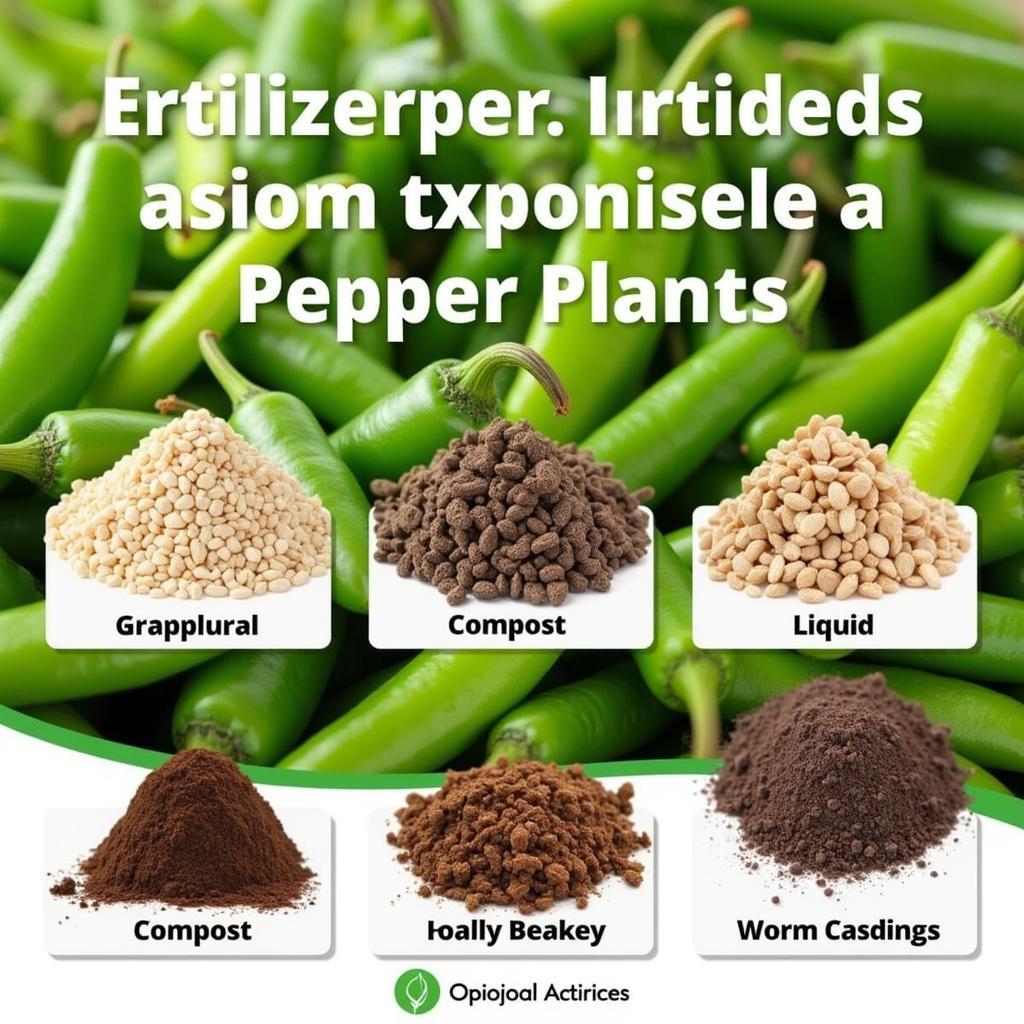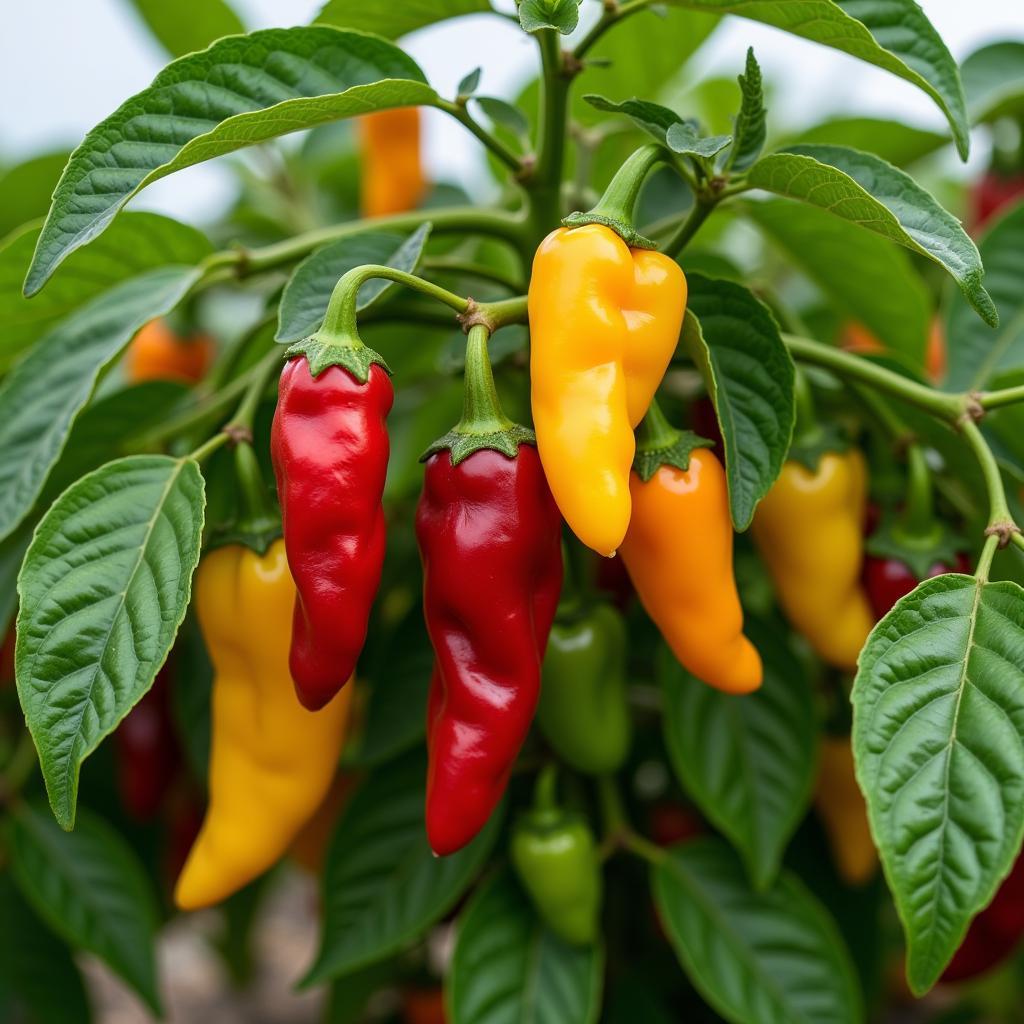Want to grow the healthiest, most productive pepper plants possible? It all starts with providing them with the right nutrients. Just like us, peppers need a balanced diet to thrive. While sunlight, water, and healthy soil are essential, using the right fertilizer can make all the difference in the world. So, let’s dive into the Best Food For Pepper Plants to help you cultivate a bountiful and delicious harvest.
Understanding the Nutritional Needs of Pepper Plants
Pepper plants are considered heavy feeders, meaning they require a good amount of nutrients to support their growth and fruit production. The three primary nutrients they need are nitrogen (N), phosphorus (P), and potassium (K), often represented as the NPK ratio on fertilizer labels.
- Nitrogen: Essential for leafy growth, vibrant green color, and overall plant vigor.
- Phosphorus: Crucial for root development, flower formation, and fruit production.
- Potassium: Strengthens plants, improves fruit quality, and enhances disease resistance.
In addition to these macronutrients, pepper plants also benefit from secondary nutrients like calcium, magnesium, and sulfur, as well as micronutrients like iron, manganese, and zinc.
Choosing the Best Fertilizer for Your Pepper Plants
Selecting the right fertilizer for your pepper plants can feel overwhelming with so many options available. Here’s a breakdown of the most popular choices:
1. Granular Fertilizers
Granular fertilizers are a popular choice for their ease of use and slow-release properties, providing a steady supply of nutrients over time. Look for a balanced fertilizer with an NPK ratio of 5-10-10 or 10-10-10.
When to Use: Apply granular fertilizer around the base of your pepper plants every 4-6 weeks throughout the growing season.
2. Liquid Fertilizers
Liquid fertilizers are quickly absorbed by plant roots, making them an excellent option for providing a fast nutrient boost. Choose a balanced liquid fertilizer or one specifically formulated for peppers.
When to Use: Apply liquid fertilizer every 2-4 weeks during the growing season, diluting it according to the instructions on the product label.
 Best Fertilizer Options
Best Fertilizer Options
3. Organic Fertilizers
For gardeners seeking a natural approach, organic fertilizers are a fantastic option. Compost, worm castings, and aged manure are excellent sources of slow-release nutrients that improve soil structure and promote beneficial microbial activity.
When to Use: Amend the soil with compost or other organic matter before planting. Top-dress around plants with compost or worm castings during the growing season.
4. Epsom Salt
While not a fertilizer, Epsom salt is a great source of magnesium and sulfur, which can enhance pepper plant growth and fruit production.
When to Use: Mix one tablespoon of Epsom salt per gallon of water and apply as a soil drench or foliar spray every 2-4 weeks.
Feeding Schedule for Pepper Plants
Establishing a regular feeding schedule ensures your pepper plants receive a consistent supply of nutrients throughout their growth cycle. Here’s a general guideline:
Before Planting: Amend the soil with compost or aged manure to provide a nutrient-rich base.
At Transplanting: Use a balanced granular fertilizer (5-10-10) or a starter solution to encourage root development.
During Vegetative Growth: Apply a nitrogen-rich fertilizer (10-10-10) or liquid fertilizer every 2-4 weeks to support leafy growth.
During Flowering and Fruiting: Switch to a fertilizer higher in phosphorus and potassium (5-15-15) to promote flower and fruit production.
 Thriving Pepper Plant
Thriving Pepper Plant
Common Signs of Nutrient Deficiencies in Pepper Plants
Recognizing nutrient deficiencies early is key to correcting them and ensuring a healthy harvest. Watch out for these telltale signs:
- Nitrogen Deficiency: Stunted growth, pale green or yellowing leaves, especially older leaves.
- Phosphorus Deficiency: Slow growth, purplish discoloration on leaves, poor root development.
- Potassium Deficiency: Browning and curling leaf margins, reduced fruit production.
Expert Tips for Optimal Pepper Plant Nutrition
“Providing the right nutrients is crucial, but equally important is ensuring your pepper plants have well-draining soil and receive adequate sunlight and water,” says Dr. Emily Carter, a leading horticulturalist specializing in vegetable gardening. “These factors work together to create the ideal environment for healthy growth and abundant yields.”
- Conduct a soil test to determine its pH and nutrient content before planting.
- Water deeply and consistently, allowing the soil to dry slightly between waterings.
- Mulch around your plants to retain moisture and suppress weeds.
- Rotate crops annually to prevent nutrient depletion and disease buildup.
Conclusion
Choosing the best food for your pepper plants is key to unlocking their full potential and enjoying a bountiful harvest of flavorful peppers. By understanding their nutritional needs, selecting the right fertilizer, and following a consistent feeding schedule, you can empower your plants to thrive. Remember to monitor them for signs of nutrient deficiencies and adjust your approach accordingly. With a little care and attention, you’ll be well on your way to growing the most delicious peppers you’ve ever tasted!
Frequently Asked Questions
1. Can I use Miracle-Gro on pepper plants?
While Miracle-Gro can be used, it’s essential to choose a formula specifically designed for vegetables or tomatoes, as these will have the appropriate NPK ratio for peppers.
2. How often should I fertilize pepper plants in containers?
Container-grown peppers may require more frequent fertilization than those planted in the ground. A good rule of thumb is to fertilize every 2 weeks with a balanced liquid fertilizer.
3. What are some natural alternatives to chemical fertilizers?
Compost, worm castings, aged manure, fish emulsion, and seaweed extract are excellent natural fertilizer options that provide a wide range of nutrients.
4. Can I over-fertilize pepper plants?
Yes, over-fertilization can lead to nutrient burn, characterized by browning leaf tips and stunted growth. Always follow the recommended application rates on fertilizer labels.
5. How do I know if my pepper plants need more calcium?
Blossom end rot, a common physiological disorder characterized by a dark, sunken lesion at the blossom end of the fruit, is often a sign of calcium deficiency.
For more information on enhancing your culinary journey with nature’s goodness, explore our articles on traditional Rhodes food and Anatolian food, which showcase the diverse flavors and culinary traditions from different parts of the world.
Remember, at Mina Cones Food, we’re always here to help you cultivate a thriving garden and create delicious meals using fresh, homegrown ingredients. For personalized advice on pepper plant care or any other culinary inquiries, don’t hesitate to contact our team at 02437655121, email us at [email protected], or visit us at 3PGH+8R9, ĐT70A, thôn Trung, Bắc Từ Liêm, Hà Nội, Việt Nam. Our dedicated customer support team is available 24/7 to assist you.